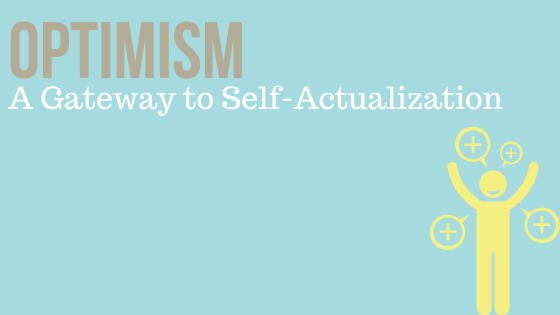Today’s blog is written by Malynn Utzinger, Director of Integrative Practices at Promega, and Tim Weitzel, ESI Architect. Reposted from the Promega Connections blog with permission.
Optimism sometimes gets a bad rap. Many people associate optimism with a sugar-coating of reality or a blind faith that all will be well. Worse, there are brands of optimism which imply that we have the power to transform the conditions of our lives through positive thinking alone, regardless of their deep-seated and/or systemic origins. However, evolving research and our own field work suggests that psychologically mature optimism, a pillar of emotional and social intelligence (ESI), is not only useful as a life-orientation, it is the gateway to self-actualization.
In our practices, we define optimism as “a mental attitude reflecting a belief or hope that the outcome of some specific endeavor, or outcomes in general, will be positive, favorable, and desirable. It is grounded belief in a reasonable chance of success.” Importantly, this belief in a reasonable chance of success comes not from blind faith or poor comprehension of actual challenges but from an assessment that our inner and outer resources are adequate to address what life brings us. This assessment gains veracity not necessarily from uninterrupted success in life, but rather from a readiness to learn about oneself and about life from everything that happens. As such, on Promega’s ESI team, we take the above definition of optimism a step further and define the optimistic person as someone with a “ . . . belief in a reasonable chance of success and the readiness to choose to learn from everything that life brings, good or bad.” We consider this to be the ultimate form of optimism, which can set us down the path to becoming our best self.

Psychologist Rick Hanson writes in his book Hardwiring Happiness that each person has two brains (metaphorically speaking): a red brain and a green brain. Oversimplifying things by necessity, the red brain is our older, reactive, and instinctive brain. Its job is to look out for threats. It drives the alertness that keeps us alive, such as vigilance around COVID-19 and a sharp eye on the highway. Even though it powers the swift actions essential to our survival, it is also characterized by an overabundance of fear, a belief in scarcity, chronic anxiety, and the many other ways we torture ourselves through self-doubt and negative stress reactions.
When the red brain cycles become chronic, they lead to pessimism and the shutdown of the capacities that lead to our bigger, more self-actualized selves. Reactive negativity engages the fight/flight/freeze response and constricts the brain connections we need for creative problem-solving and resilience. We are more inclined to get defensive, argue, give up on our plans, and blot out our ability to see ourselves in terms of our greatest potential. Even our attempts at growth tend to be driven by moving away from what we fear, e.g., failure and being alone versus what we aspire to like success, creativity, and meaningful connections to others.
The green brain, by contrast, is our more recently evolved, intention-driven brain, characterized by skillful reflection, relaxed confidence, strength, openness, and aspiration towards our best selves. The green brain requires cultivation of a bigger, more generative picture, and this takes practice. For example, during the COVID-19 pandemic, our green brain might call us to think beyond ourselves, practicing compassion and thoughtful analysis to wear masks for the sake of people we don’t even know. The green brain also helps us to use this time to assess what really matters in our life and recommit to our essential path.
From this perspective, strengthening our green brain enables us to take the optimistic stance, which is not just believing good will come or even just believing in our inner and outer resources, but also investigating everyday events to find ways to learn and grow. This small, daily practice of optimism is one of the most potent ways of getting our inner and outer resources to take root and grow stronger. In this way, we can self-regulate ourselves towards the more proactive, creative, inner-resource-building, and self-actualizing green brain.
Studies show that optimism impacts our brains by relaxing or overriding the red brain networks and engaging our green brain openness, resilience, strength, confidence, and so many more of our finest human qualities. And when we choose the optimistic, learning perspective, our growth is driven by our fulfillment, abundance, and our felt sense of appreciation in the smallest and the largest of life’s circumstances. Living these qualities moves us towards our self-actualization more robustly than living from unexamined fear. In fact, Positive Psychology asserts that the opposite of debilitating depression is not happiness, but a learning-oriented optimism.
In closing, an optimism that includes a fundamental learning orientation is cultivated through polishing our lens on life through the everyday reflective and proactive practices we engage to keep the pipeline of openness and growth flowing. This learning orientation is the bedrock of the perspective that all of life—joy, sorrow, peace, anxiety, hope, despair, success, failure—offers us the opportunity to grow, become more open, gain needed inner resources, and increase our gravitas. What normally might set us back, harden our hearts, and close our minds becomes a path to awakening the best inside us, which is the heart of self-actualization.
WOULD YOU LIKE TO SEE MORE ARTICLES LIKE THIS? SUBSCRIBE TO THE ISHI BLOG BELOW!
SUBSCRIBE NOW!


